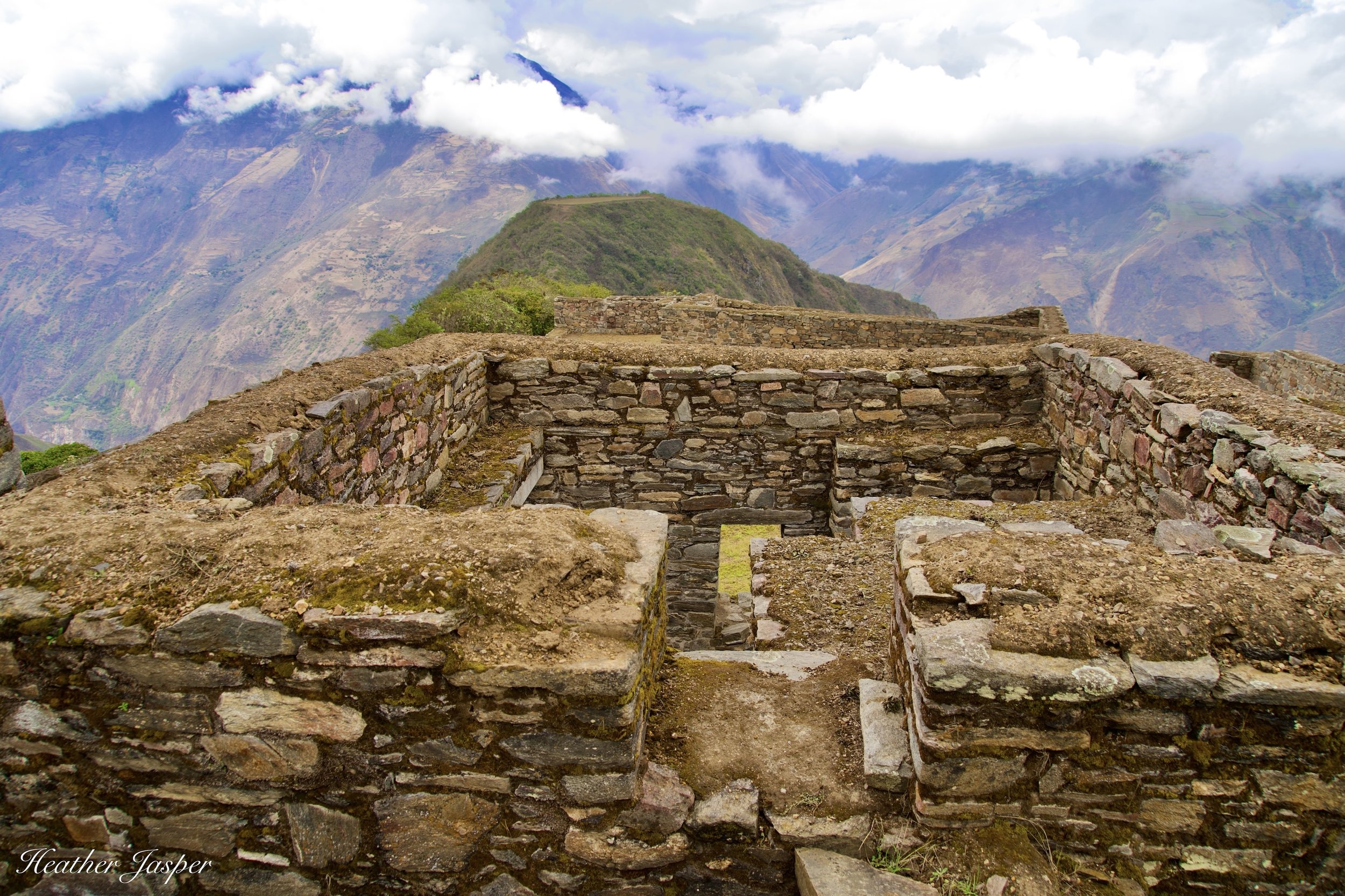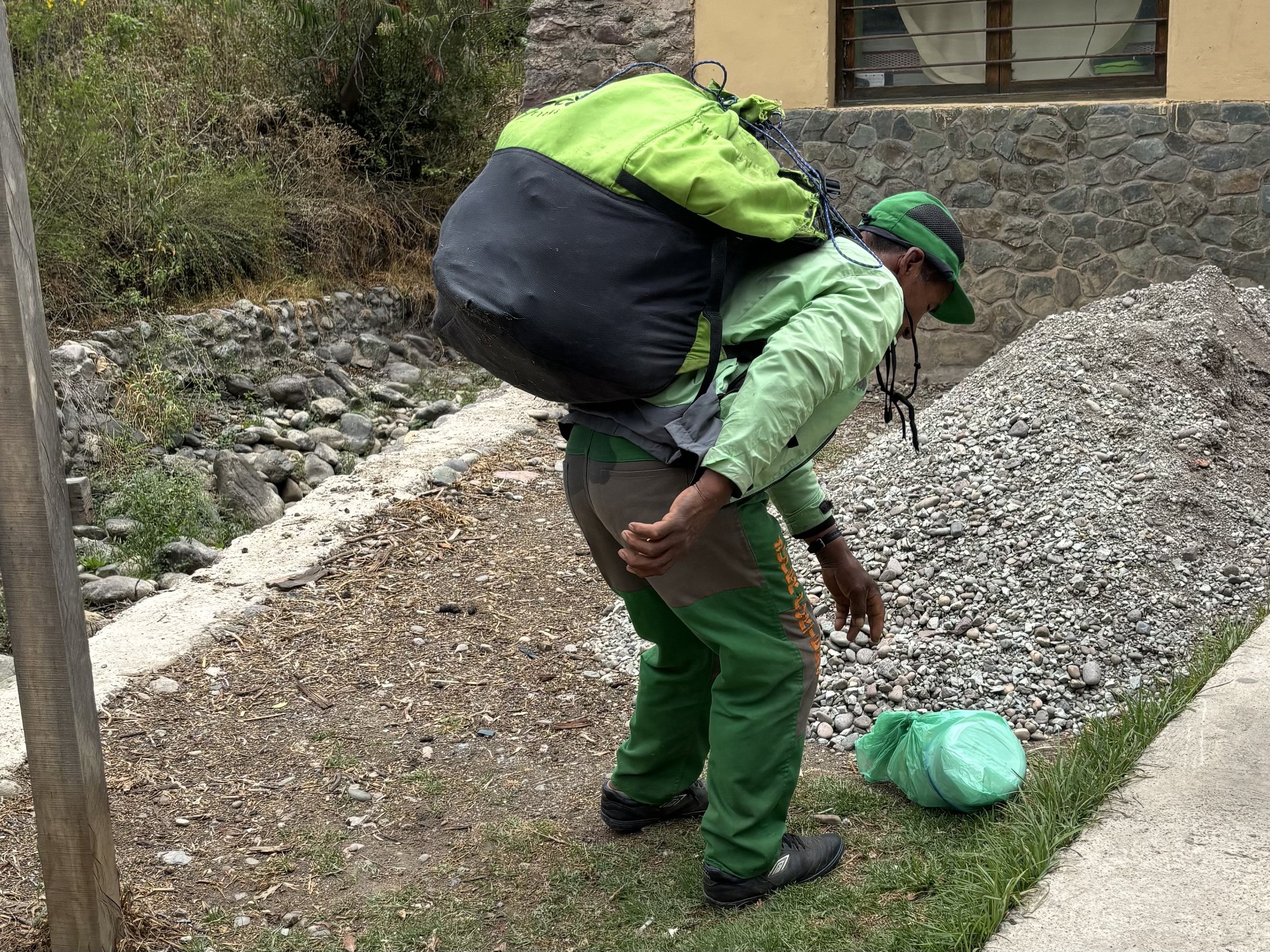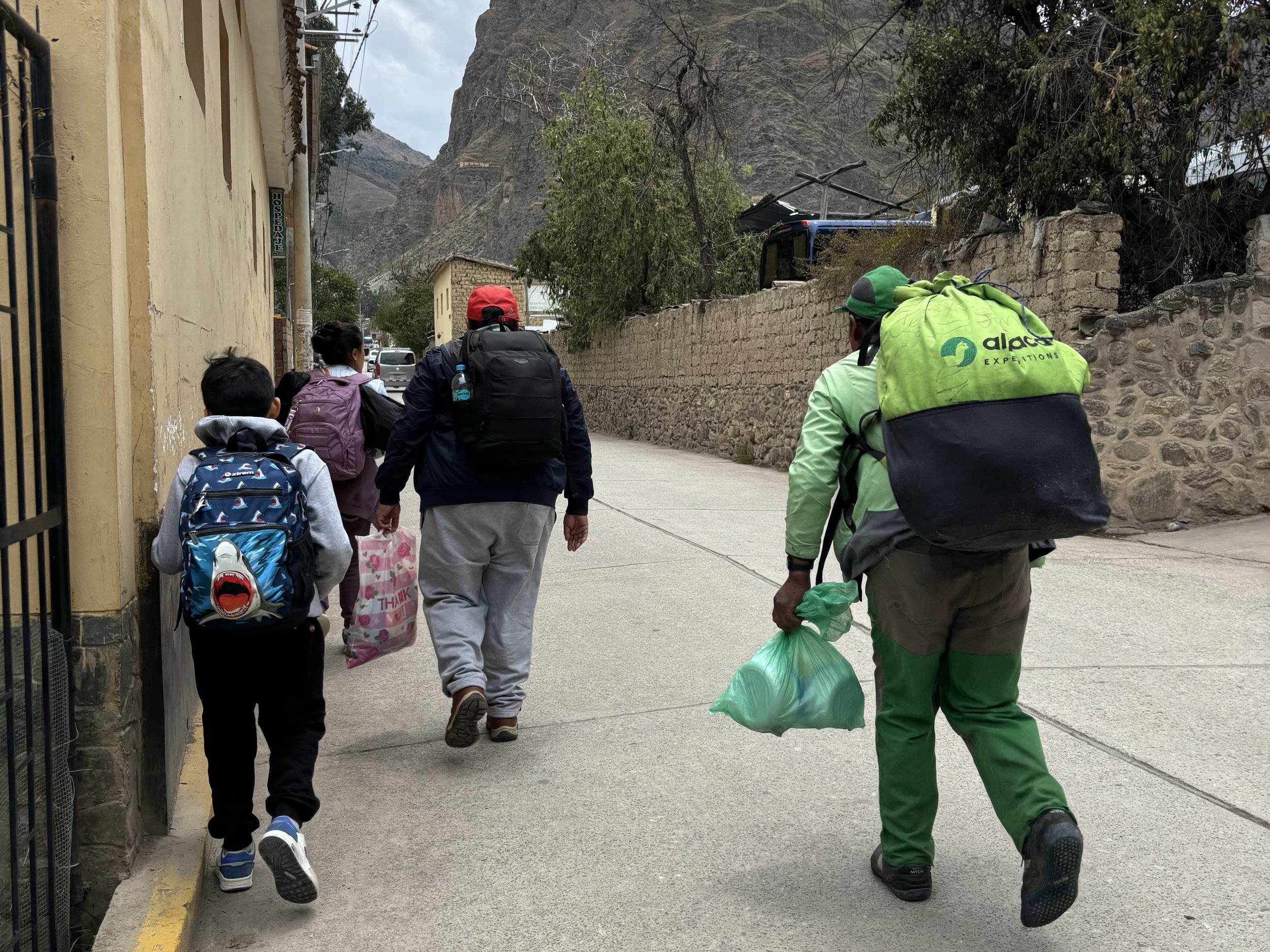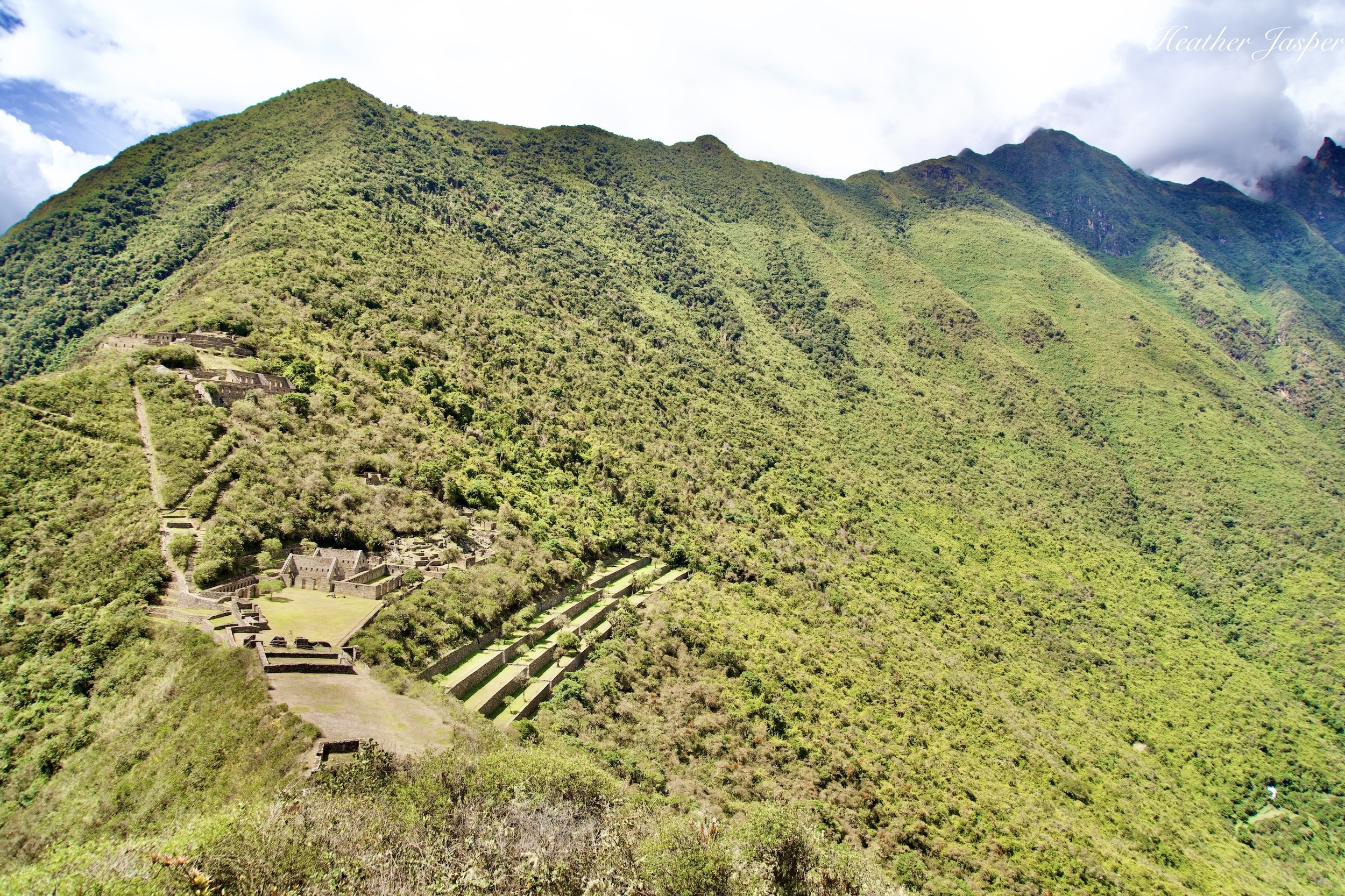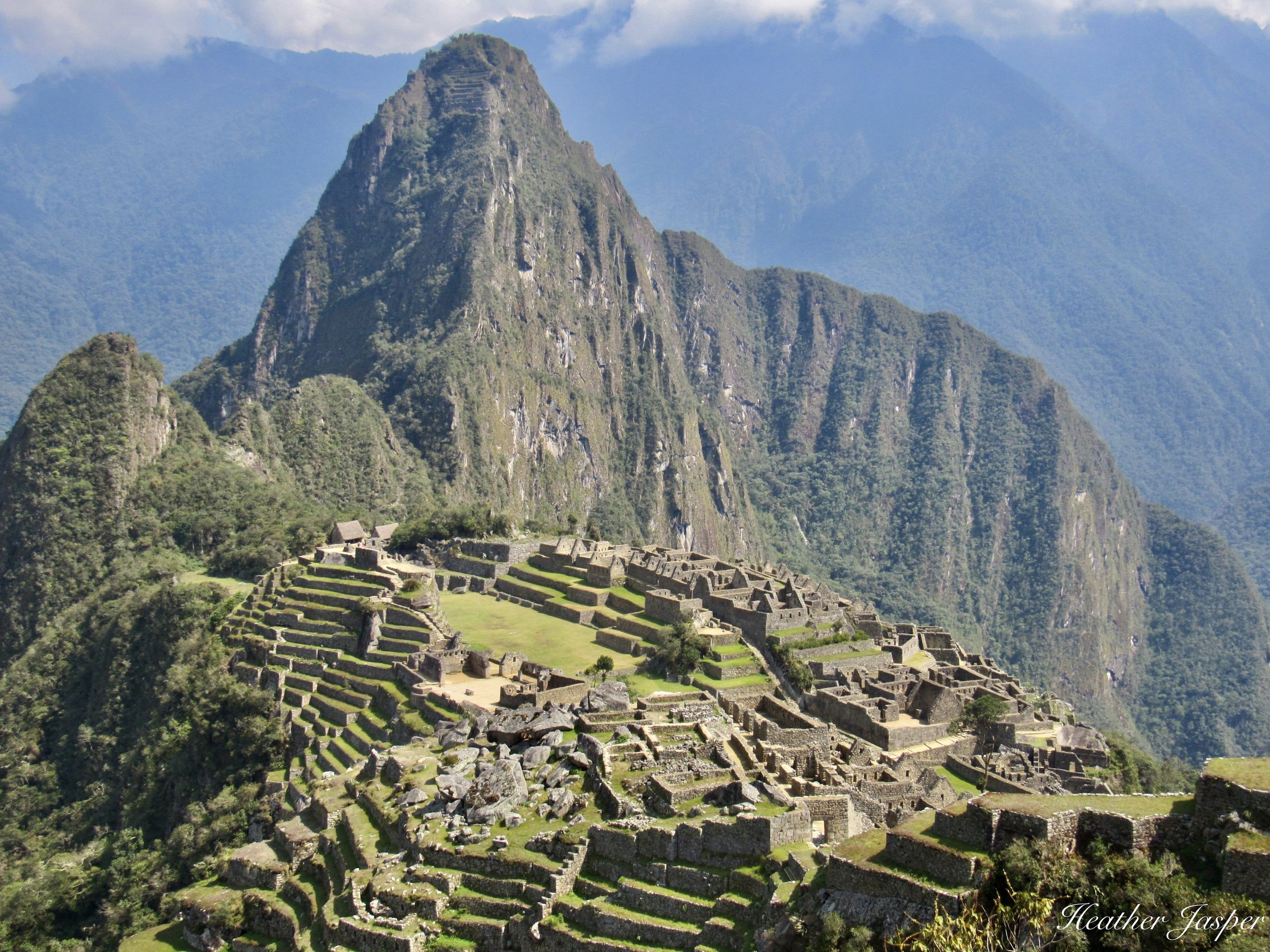Don’t do the Inca Trail
Hiking to Machu Picchu from km104 still gets you this view from the famous Inti Punku, aka the Sun Gate, without porters and without camping.
New 2026 Inca Trail Updates
Inca Trail permits for 2026 go on sale October 27 and will not automatically include a ticket to Machu Picchu. The past few years it included the 3B circuit through Machu Picchu, pictured below. Read more 2026 updates on this blog.
If you hike the Inca Trail in 2026 and want to see the main temples at Machu Picchu, labeled 6 on this map, you will have to buy a separate, second ticket to Machu Picchu.
Don’t Hike the Inca Trail
Everybody who wants to come to Peru will see tons of advertising about the Inca Trail. Inca Trail permits go on sale every October for the following year, which means that most people see advertising pressuring them to book now! Don’t wait! You have to reserve your Inca Trail permit at least 6 months in advance!
As if the only thing to do in Peru was the Inca Trail? There are so many other places to see and things to do that I recommend more than the Inca Trail!
Read my BBC article about hiking the Inca Trail ethically.
My recommendation to not do the Inca Trail is based off years writing about tourism in Cusco, interviewing dozens of guides, porters, and tour agencies, following the news here in Peru and a lot of research. I have already written about Inca Trail problems for Horizon Guides.
Choquequirao is known as the sister site to Machu Picchu and the trek is beautiful!
Here is why you shouldn’t do the Inca Trail.
· There are too many workers’ rights and human rights abuses that the porters suffer from and almost no improvements in the system over years.
· The Inca Trail does not have adequate emergency services and it is a very strenuous trail.
· There is no incentive for lawmakers to improve the system for tourists or workers.
· There are plenty of other amazing treks to do in Peru, even one that leads you directly to Machu Picchu. All the photos in this blog are those other treks.
I’ll unpack all of that for you, with the questions people usually ask me about these problems.
The Lares trek takes you out into the Andes where you’ll pass lakes and alpaca corrals like these far below.
Why are there porters on the Inca Trail?
Sections of the Inca Trail are ancient stone and allowing mules or horses on the trail would destroy it in a day. It’s in the Machu Picchu Historic Sanctuary, which functions like a national park, and the focus is on preserving the archeological sites along the way. It is highly regulated, with designated campsites, maintained trails and permits that are non-transferable and non-refundable. Only licensed agencies can sell Inca Trail permits and their systems are also highly regulated by the government. It is illegal to do the Inca Trail without porters, unless you carry all your own gear.
Why can’t trekkers carry their own stuff?
Most of the Inca Trail is at high altitude, up to 13,828 feet above sea level (4,215 meters) and most trekkers live at sea level and don’t have enough time at altitude to sufficiently acclimatize. They’re either unable to carry a big backpack because of the altitude or because of their general fitness level. There are no fitness tests to see if people are actually capable of doing the trail before they start.
The Ausangate trek uses mules, not humans to carry camping equipment.
What do Inca Trail porters do?
Porters carry all the tents, sleeping bags, food, dishes, utensils, cook stoves, gas cannisters, duffels with tourists’ personal belongings, and even tables and chairs. They carry more stuff than I would put in a car for a weekend camping trip.
They wake up before dawn to help the cook get breakfast ready, wake the tourists and serve them coffee or tea in their tents. They break down tents while the tourists eat, and pack up the kitchen after breakfast. They hike fast enough to pass the tourists on the trail so that they can get to the lunch spot to set up the dining tent and cook lunch before the tourists get there, then pack everything up again and pass the tourists on the trail to get to camp and have everything set up and dinner about ready when the tourists straggle in. They stay up till 10 or 11pm cleaning up after dinner, sleep a few hours and get up at 5am to do it all again.
Mules carry gear on the Choquequirao trail.
If we pay them to carry things, what’s the problem?
All trekking agencies’ websites have photos of their porters, showing them hard at work on the trail. Look for photos of them with their packs. The shoulder straps are insufficient, they don’t have waist belts, most of the packs aren’t waterproof and they are large and bulky. Some agencies give them back braces, which are very uncomfortable and restrict breathing, but they’re cheaper than decent backpacks.
Porter backpacks are terrible
I wouldn’t wear those backpacks for 10 pounds of gear on flat ground at sea level. Requiring porters to use them to carry 44lbs on steep trails at high altitude is cruel.
The biggest complaint I’ve heard from porters is that they feel they’re treated like animals. The system is dehumanizing. Remember, they’re paid to carry gear, but only within reason.
What do Inca Trail porters eat?
Like sleeping arrangements, this is not regulated and in the absence of regulations comes a lot of abuse. Most agencies give the porters the leftovers after the tourists have eaten. Some provide them with other food, and some give them a little money and tell them to buy and carry their own food on top of what they’re already carrying. Sometimes they have basics like rice and pasta, but there’s often no fuel to cook with or they have to wait until the tourists’ dinner is cooked before they can use the stove and cooking pots. If they are able to do their own cooking, they may be up until after midnight eating and cleaning up.
What they drink is just as big of a problem. At every meal tourists bring their water bottles and get them filled with boiled water than has been cooled and filtered. Few agencies allot fuel for boiling water for the porters also. They fill their water bottles at the taps at each camp, which is relatively clean water but not actually safe to drink.
Where do Inca Trail porters sleep?
This is something that has finally improved in the past year. After years of protests and strikes, a bunkhouse was built for porters at the first campsite. The second campsite also has a new building where porters can sleep in a dry place. However, they’re not big enough and not all porters get to sleep there. Some porters are still left with the past lack of decent places to sleep.
Most agencies don’t provide tents for the porters and ask them to sleep all together on the ground in the dining tent. That means they have to wait until all the tourists are done with dinner to take out the tables and chairs and put down their sleeping mats or blankets. Dining tents do not have floors so most of the time they’re sleeping in the mud. If it rains during the night, the tent might flood and then they end up sleeping in the only buildings around: the bathrooms. Some agencies do provide normal tents for porters to sleep in, but they’re the rare exception.
Local families rent cabins at Choquequirao, so you don’t have to take camping equipment or hire mules.
Do women work on the Inca Trail?
I know several women who are excellent Inca Trail guides and it’s very common to see women guides on the trail. Some women do work as porters, but this is complicated for many reasons. One is that by law they can only be given 15 kilos (33lbs) to carry, though they must be paid the same as men who carry 20kg, which means few trekking agencies want to hire more than a few token women. Another problem is the sleeping arrangements and the lack of bathrooms for privacy. Some obvious solutions are to hire more than one or two token women, give them a separate place to sleep and pressure the Ministry of Culture to improve the bathrooms. One woman porter I spoke with told me that another problem is the sexism in Peruvian culture. Not many women will tolerate the treatment they receive from male porters and even male guides.
What are Inca Trail porters paid, and why is this a problem?
What they’re actually paid is very hard to determine because most agencies pay less than required and make them carry more than allowed. No agency will admit to paying below the minimum wage, but after years investigating this, I know that almost all are underpaid.
Porter pay has been so low for so long that it now has to be regulated by congress and the law must be signed by the president of Peru. Politicians are so far removed from the daily life of porters that it’s like politicians in New York making laws for workers in rural Texas. Also, laws in Peru are rarely enforced. Lawmakers in Lima may make headlines for progressive laws but rarely designate a budget for the enforcement of these laws.
The fact that agencies brag about paying the minimum seems to me like part of the problem. What company brags about paying minimum wage? Don’t good workers usually get more than the minimum? I don’t know a single company in Cusco that pays more than minimum wage, no matter how hard the porters work or how many years they’ve worked for the company.
Me with the mules who carried my gear on the Ausangate trek.
What is the minimum wage?
The minimum wage for porters is constantly in flux. It is always per trip, for four days of hard labor. For several years it was s/350 soles (about $95 USD), then in 2022 it was raised to s/650 soles ($175). That only lasted for a few months until lawyers representing tour agencies got a judge to strike it down. Most agencies now pay s/350 for four days of work carrying 20 kilos (44 pounds), though it’s common knowledge in Cusco that most porters carry 30kg and the worst agencies load up to 40kg (88lbs) on their porters.
Do Inca Trail porters get a livable wage?
If porters work consistently through the dry season, which is also the high tourist season, s/350 is a livable wage. However, this isn’t the point. Making enough money to survive and being paid to sufficiently compensate for backbreaking labor isn’t the same thing. Comparing the wage of a porter to that of an average worker makes about as much sense as comparing the wage of firefighters who work wildfires to the wage of a 7/11 clerk. The work is so different that the comparison is meaningless.
Doesn’t anybody check how much porters’ packs weigh?
Yes, there are check points on the first and second days of the trek. However, the first day the trail goes past several communities who use mules and motorcycles for their own transportation. Many trekking agencies give 20 kilos to each porter, then put the rest on mules until the first campground. The second day, some agencies hire a few “ghost porters” from the communities to carry things just to the second check point. After the second check point, the packs routinely weigh 30 kilos for the day when they’re hiking through the cloud forest on slippery paths that are always wet.
The Ausangate trek goes by spectacular glaciers, something that the Inca Trail doesn’t have at all.
Why don’t agencies just get more porters?
There are two problems with getting more porters. The first is that they’d have to pay more porters, and their profit margin goes down. The second is that the government only sells 500 permits per day for the Inca Trail. About 200 go to paying clients and the others go to guides and porters. At least the porters don’t have to pay for a permit. They won’t increase the number of people allowed because of the small campgrounds and strain on the ecosystem and trail to have so many people every day.
Do porters have health insurance?
The short answer is yes, because all Peruvians have the right to healthcare. What kind of healthcare they receive is more complicated. This is because there are two health systems in Peru and the villages they live in usually only have access to the first system.
The first is for people who don’t have a work contract, who either work for themselves or work informally. Depending on the year, 70-75% of Peruvians work informally. This first system is free for all Peruvians who don’t have health insurance and is a network of rural clinics called posta and national hospitals in large cities.
The second system is for anybody with a work contract, who pays into the national Essalud insurance system, like me. Essalud hospitals usually have better equipment and shorter lines, though most Peruvians with money pay for private hospitals and clinics. The Essalud system is only available in cities and anybody in the Essalud system cannot go to posta or national hospitals. If porters are registered as formal workers with contracts and health insurance, then they cannot go to the posta in their villages and the rural areas where they live. They must travel to large cities for all healthcare at Essalud hospitals.
The Ausangate trek also goes through high Andean meadows and is a truly lovely four days.
Does anybody advocate for the porters?
Yes, kind of. There is a porters’ association, though it has limited effectiveness. Some local politicians claim to advocate for the porters. One of the problems with this is that tour agencies rake in a lot of money, and they pay for lawyers who advocate for their interests, based on the principles of unchecked capitalism. The porters’ association representatives are frequently discouraged and tell me that they feel nobody listens to them.
There are periodic checks on workers’ conditions, and I’ve spoken with several guides who had undercover government employees among their groups. However, every guide then told me that they didn’t ever get a report or see any change. The Peruvian government agency Sunafil (Superintendent of National Labor Enforcement) did a sting in 2019 to enforce law 27607 but it didn’t lead to any changes according to my sources.
Don’t trust everything you see online
The Alpaca Expeditions website says that porters get to ride a bus just like travelers, but I see them walking everywhere in Ollantaytambo.
Are things getting better for the porters?
Besides the new bunkhouses, not really. There are constant changes to what’s commonly called the porters’ law (Ley del Porteador). These changes were to amend or replace 27607 was enacted in December 2001, until in November 13th 2022 the “new” law 31614 was approved, which made significant changes, some of which benefited porters and others made their lives harder.
Travelers who want to hike the Inca Trail can change everything! In a system where politicians and company owners don’t have any incentive to improve working conditions, it’s the clients who spend their money in Peru who have all the power. If everybody who wants to hike the Inca Trail insists on ethical treatment for porters, the companies will have to improve working conditions.
The Inca ruins at Choquequirao are just as amazing as Machu Picchu in many ways.
Is there any support for retired porters?
No. They are entitled to the same healthcare system as everybody else, but they don’t get any special attention for their destroyed knees and shoulders. Young men, and some women, routinely strain their joints carrying heavy loads, not thinking of the consequences that they’ll pay in 30 or 40 years. Honestly, how many people in their 20s in any country from any culture really consider the impact their choices will have on their joints when they’re older?
Why does anybody work as a porter on the Inca Trail?
Most porters come from rural areas where the only other job available to them is subsistence farming. Almost anything is better than that. Being a porter on the Inca Trail can be good money and lots of people love hiking, even with heavy loads on their backs. Working consistently June, July and August a porter can earn far more than those same three months farming potatoes or herding alpacas. If they do it right, in six months they can earn enough to survive for the other half of the year. However, earning enough to survive isn’t the same as being appropriately compensated for hard work. People who work as hard as Inca Trail porters deserve more than mere survival.
Some of the buildings at Choquequirao have been restored similarly to the restoration at Machu Picchu.
Why do people hike the Inca Trail?
The Inca Trail leads 26 miles (42km) through the Machu Picchu Historic Sanctuary (MPHS), past six major archeological sites and innumerable small sites. Both the MPHS and the system of Inca trails that radiates out from Cusco are UNESCO World Heritage Sites.
The ecosystems that you hike through are truly astonishing and diverse. Every hour you may pass from one micro-climate to another, with visible changes in the flora and fauna. More than 200 species of birds have been identified along the trail and more than 400 species live in the MPHS. There is no light pollution and closest city is Cusco, 25 miles (40km) away, so at night the stars feel close enough to touch.
Please note, except for the individual archeological sites, all of this is also present on other treks in the area, especially Choquequirao.
The first glimpse of Wiñay Wayna on the short Inca Trail from km104, not the 4-day Inca Trail.
Should I tip guides and porters on the Inca Trail?
Yes. Guides should be tipped in accordance with how well they do their jobs and porters should be tipped because they’re doing a lot of hard work so you don’t have to. Also, they rely on tips to make up for the poor pay. However, tips don’t solve the problem that the system is unfair and dehumanizing.
Are there any good agencies for the Inca Trail?
There are some agencies that try to treat their porters well, but they are still working in the same system as the agencies that take advantage of porters at every turn. The system is unfair, unjust, corrupt and designed to take advantage of the porters. People who work in the system and want to help the porters get just as frustrated with the system as the porters themselves.
If nobody does the Inca Trail, what will the porters do?
If demand for the Inca Trail decreases (which is doubtful given the limited number of permits per day), and people do other treks instead, agencies will have to hire more cooks and muleteers for the other treks. Working with mules is very different from being treated like a mule. Also, if more travelers opt for homestays and visiting rural communities, the porters can stay in their villages and earn money from tourism without destroying their knees or being separated from their family. Two great organizations that arrange homestays in the Sacred Valley are Yachaqs and La Base Lamay.
Hiking the short Inca Trail from km104 you arrive at Machu Picchu in the afternoon with fewer crowds.
What is the Short Inca Trail from km104?
This is the best trail and what I always recommend that everybody do. It’s basically the last day of the regular 4-day Inca Trail from km82. The km104 trail goes to my favorite Inca site on the whole trail: Wiñay Wayna. There are no porters because you’re not camping on the trail. You hike from km104 to Machu Picchu, where you arrive in the afternoon and get to see the ruins with soft afternoon light. That evening you go down to the town of Aguas Calientes and sleep in a hotel. The next morning you do the full tour of Machu Picchu and that same day take the train and/or bus back to Cusco.
What other treks can you do besides the Inca Trail?
I love this question. My favorite multi-day treks are Choquequirao, Lares, Ausangate, Quarry and Salkantay. My top favorite day hikes are the Short Inca Trail, Waqra Pukará and Pisac. Take a look at the photos throughout this blog to see what these treks look like. Click on the name of each place in this paragraph to read my blogs about my experience on each trek. I’ve done several of these treks multiple times. I promise that they are all fabulous and equal to the Inca Trail in many ways, though they are all far superior to the Inca Trail in that they do not require human porters to carry your gear.
My favorite option is Lares + the Short Inca Trail.
If you hike Lares 3 days & 2 nights, you go through beautiful Andean valleys, past picturesque villages and herds of alpacas. Then you arrive at the Lares hot springs, can soak in the hot springs and then take a van to Ollantaytambo. Sleep in a hotel in Ollantaytambo, take the train the next morning to km104 and hike to Machu Picchu. You still get hiking, camping, and Machu Picchu, but this itinerary gives you several things the Inca Trail doesn’t: hot springs, villages, herds of alpacas, some nights in hotels, and seeing Machu Picchu both in the afternoon and again the next morning.
Only part of the Choquequirao ruins have been uncovered. That whole hillside of jungle covers many more ruins.
Can I do the Inca Trail ethically and responsibly?
Sort of. You can book with a socially responsible company that gives porters good backpacks, has lightweight tents for both clients and porters, doesn’t promise extravagant meals of heavy fruits and vegetables, pays porters the minimum and doesn’t ask them to carry more than 20kg.
The problem is that all companies will tell you they treat their porters fairly. The company I hear the most complaints about from porters and guides is Alpaca Expeditions, yet their website brags about how well they treat their porters. I don’t trust anything they say, first because of the complaints I’ve heard from porters & guides, second because their TripAdvisor reviews are full of complaints about how they treat porters, and third because when I went to their office to ask about a trek the sales rep told me that they were the first company to employ women porters, which I know isn’t true. Evolution Treks was the first to hire women porters, and to treat them well.
If you are interested in porters’ rights, please read this Fodor’s Travel article about porters in Nepal by Sara Frenning “Dying for your vacation: The travel workers risking their lives for $10 a day.”
Choquequirao has an “usnu,” a flattened area used by the Inca for ceremonies and events.
Can I trust online reviews of trekking agencies?
Sometimes. Most international travelers love their experience and their guide, so they write generally positive reviews. If they notice how badly the porters are treated, they’re afraid to write about the negative things because the guides are so wonderful that they don’t want their guide to face any repercussions. Also, most travelers are in Peru on vacation, they want to focus on the positives and enjoy their experience. Consciously or subconsciously, most look the other way when they see something that makes them feel uncomfortable or complicit in something they know is wrong.
Why don’t more trekkers protest or talk about problems on the Inca Trail?
Many of these problems are well hidden, especially pay, food, water and sleeping conditions. It’s obvious to anybody with a critical eye that most companies give their porters unsuitable backpacks. If you look around camp, you’ll see heavy tents, tables, plastic stools to sit on for meals and meals made with heavy fresh food, not lightweight or dehydrated food. However, most trekkers are so exhausted at the end of the day that they collapse in their tents without realizing that the porters don’t have tents.
Do the Inca Trail porters ever protest?
Yes. Almost every year there are protests in December, January and/or February. This is the low season and the rainy season, so there is less work and it’s less of a financial strain from not working for a week or two. Almost every time that porters start to organize for a protest, tour agencies find some way to threaten them. When they do manage to enact a strike or protest, it accomplishes little because of the problems in the next question.
Andean Quechua-speaking people live along the Lares Trek and herd their llamas and alpacas.
Why aren’t things getting better for the porters? Why doesn’t the system change?
Unfortunately, bureaucracy and corruption are major problems in Peru. According to Transparency.org Peru is getting more corrupt. From 2022 to 2023 Peru dropped three points and now scores 33/100 for corruption. It’s ranked as the 121st country out of 180 countries. For context, Denmark ranks as the least corrupt country in the world with a score of 90 and Somalia ranks as the most corrupt country with a score of 11. Other countries that scored the same as Peru are Angola, Mongolia and Uzbekistan. India, with all its problems, scored 39. In 2020 Peru scored 38/100, showing that while I’ve lived in Peru, every year it is objectively more corrupt. Lawmakers in Lima have no more interested in helping the porters than they do in helping any other disenfranchised group who is too poor to pay bribes.
You have the power and the responsibility to change this.
I think the only people with the power to change things are the tourists who choose where to spend their money in Peru. It does make a difference to choose a different trek (Choquequirao, Lares, Salkantay, etc.) or to choose an ethical agency for the Inca Trail (Evolution Treks). If you hike the Inca Trail and see something, say something. If you don’t want blowback on your guide, don’t mention their name in the review.
However, it’s the responsibility of all international travelers to be honest about what they see on the Inca Trail so that other travelers can make informed decisions. More people will read your TripAdvisor review than will read this blog – especially all the way to the end!
I loved hiking by herds of llamas and alpacas on the Lares Trek and then ending at the Lares hot springs.
Is the Inca Trail safe?
The Machu Picchu Historic Sanctuary is a carefully protected and regulated area. It is safe in terms of theft or violence. However, there is a major lack of rescue capacity and a serious lack of healthcare. In 2023, an American tourist died on the first day of the Inca Trail, before it even leaves the area where people live. According to news reports, on October 12th the 67-year-old Richard Frank Pochron collapsed around 5pm, experienced convulsions and then died. More than two weeks later, I couldn’t find any news updates about what exactly happened to him. He was at a lower altitude than Cusco, which can still be high enough to affect somebody, but my guess is that he died of a heart attack, unless he had epilepsy or some other condition that can cause convulsions as witnesses described.
The point is that you may be around people who know CPR but it’s extremely difficult to get any kind of medical care on the Inca Trail. No trekking agency I know carries AEDs. Evacuations are also extremely difficult. The Inca Trail should have mini-clinics or first aid stations at periodic intervals both for the trekkers who aren’t used to the altitude and trekking, and also for the porters who frequently injure their knees or shoulders because of the heavy backpacks they carry.
Who am I to make all these allegations?
I have recorded interviews from several guides and porters for the article I wrote about problems on the Inca Trail for Horizon Guides and for BBC Travel. I have hiked the Inca Trail twice and seen with my own eyes that porters don’t have tents and sleeping bags. I’ve seen their oversize backpacks with inadequate shoulder straps and no waist belt. I’ve seen the meals made for tourists with fresh food that’s ridiculously heavy and the plain rice given to porters. I’ve seen the big dining tents made with heavy fabric and poles, full of tables and chairs for the tourists to sit at. I’ve seen porters fill their water bottles from taps at campsites that don’t have safe water. I have a recorded interview with the president of the porters’ association, Miguel Mayta, who told me that most porters are still paid less than the minimum wage and also asked to carry more than the legal 20kg. I have seen so much that I feel a responsibility to share this information.
Hiking the short Inca Trail from km104 you arrive through the Sun Gate and see Machu Picchu in the afternoon, then you sleep in a hotel and do the full tour of Machu Picchu the next morning.



